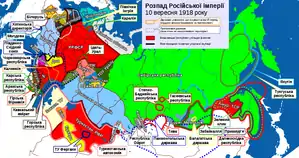State of Buryat-Mongolia
The State of Buryat-Mongolia (Buryat Cyrillic: Буряад-Монгол улас, Buryat Mongolian script: ᠪᠤᠷᠢᠠᠳ ᠮᠣᠩᠭᠣᠯ ᠪᠤᠯᠤᠰ)[lower-alpha 1] was a buffer Buryat-Mongolian state,[1] which existed during the Russian Civil War. It was established according to the decision of the first All-Buryat congress on 25 April 1917. The main government body was Burnatskom, the Buryat National Committee.[1]
State of Buryat-Mongolia | |||||||||||||
|---|---|---|---|---|---|---|---|---|---|---|---|---|---|
| 1917–1921 | |||||||||||||
 Buryat-Mongolia and former Russian Empire in 1918 | |||||||||||||
| Capital | Chita | ||||||||||||
| Common languages | Buryat-Mongolian, Mongolian, Russian | ||||||||||||
| Religion | Tibetan Buddhism, Orthodox Christianity | ||||||||||||
| Government | Republic | ||||||||||||
| Legislature | Burnatskom | ||||||||||||
| History | |||||||||||||
| 25 April 1917 | |||||||||||||
| 1921 | |||||||||||||
| Currency | Rouble of Russian Empire | ||||||||||||
| |||||||||||||
After the collapse of the Soviet regime under the advancement of the Whites and the Czechoslovakian division, the State of Buryat-Mongolia was recognized by the Soviets in 1918, and later also by Grigory Semyonov's Government of Transbaikalia.[2] The state de facto ceased to exist after the formation of the Far Eastern Republic, which had divided Buryat-Mongolia in two halves: 4 aimags became part of the Far Eastern Republic, while the other 4 formed Buryat-Mongol autonomies of RSFSR.
Notes
- Properly written from top to botom: ᠪᠤᠷᠢᠠᠳ ᠮᠣᠩᠭᠣᠯ ᠤᠯᠤᠰ
References
- Бабаков В. В., Бурнацком - Бурнардума: первый опыт национально-государственного строительства в Бурятии, Улан-Удэ, 1997 г.
- Образование Бурят-Монгольской АССР как реализация национальной политики Советского государства